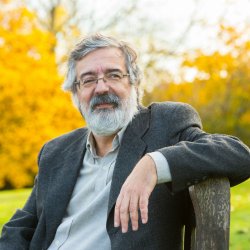Coherent electron transport in energy generation processes by electroactive microorganisms
Electrogenic microorganisms are able to transfer electrons to an external solid acceptor such as an electrode. If the electrode is connected via an external circuit to a cathode, an electric current (of the order of mW/m2 of anode) is produced. There is an ongoing discussion about the true nature of the mechanisms involved, either electron hopping or electron tunnelling.
Start date
1 October 2023Duration
3.5 yearsApplication deadline
Funding source
Faculty of Health and Medical Sciences at the University of SurreyFunding information
Funding is for 3.5 years and includes UKRI-aligned stipend (£17,668 pa for 2022-23), approved University of Surrey fees and a research budget.
About
Electrogenic microorganisms are able to transfer electrons to an external solid acceptor such as an electrode. If the electrode is connected via an external circuit to a cathode, an electric current (of the order of mW/m2 of anode) is produced. There is an ongoing discussion about the true nature of the mechanisms involved, either electron hopping or electron tunnelling.
We propose using semiconductors as opposed to metals to study these systems, as the potential gradient which can be produced on their surface will allow selective growth of microorganisms with different redox potentials, and the consequent improved transfer of electrons from the microorganism to the electrical system.
Geobacter sulfurreducens is the model electrogenic bacterium able to form biofilms on the surface of electrodes and transfer electrons directly to them. G. sulfurreducens expresses various [Ni-Fe] hydrogenases, and can produce conductive protein nanowires. Those proteic nanowires are composed by c-type cytochromes, and tehir conductivities are similar to those of carbon nanotubes. The nanowires participate in the transfer of electrons between cells and external acceptors (e.g. insoluble minerals or electrodes). It has been recently shown that the conductivity of G. sulfurreducens nanowires is enhanced by light.
Other type of bacteria able to conduct electricity over long distances (1cm) are the so-called cable bacteria, filamentous bacteria that are able to connect electron donors to electron acceptors, effectively connecting separated oxidation and reduction reactions such as reduction of oxidants (oxygen or nitrate) present at the surface to the oxidation of reducers (e.g. sulfide) present in anoxic environments such as underwater sediments.
Objectives of project
- Explore in detail the electron transport mechanisms between electrogenic bacteria and electrodes, to elucidate if these are classical conductive transport, ion transport, or if they involve quantum tunnelling along the active redox sites present in proteins and enzymes.
- Examine how the use of a semiconductor as the terminal acceptor (the electrode) affects microbial metabolism and electron transfer, and their differences with classic metallic (or carbon) electrodes.
- Analyse how the electron donation process from microorganism is constrained by the semiconductor properties. Semiconductors possess energy-band gaps for electrons, so electrons in them can exist only on discrete potential / energy levels. Therefore, microorganisms can change the energy-level at which they are donating electrons only in discrete steps. This should influence the metabolism of a microbial species with respect to its electrogenicity.
- Quantum effects permit the formation of a potential gradient along an electrode, allowing electrogenic microbes to colonize the region of the electrode where the potential match their preferred donation voltage. If different species colonize the electrode, the potential gradient will allow for the segregation of a multi-species community, where different species sharing a common biochemical habitat would occupy their own electric habitat along the gradient. We would like to elucidate if species donating electrons to the electrode at their preferred potential would still exchange partially oxidised organic compounds between them, increasing the efficiency of the system.
References
- El-Naggar et al PNAS (2010) 107(42), 18127–18131
- Li et al 2022 doi.org/10.1016/j.bioelechem.2022.108195
- Misra et al 2019. J. Am. Chem. Soc. 141, 19198−19202
- Polizzi et al Faraday Discuss 155, 43–62
- Wigginton et al Geochim Cosmochim Acta (2007) 71, 543–555
- Xian-Wei Liu et al Sci Reports 4, 3732 DOI: 10.1038/srep03732
- Zhou et al 2019. Biotechnol Biofuels 31:133. doi: 10.1186/s13068-019-1477-9.
Eligibility criteria
Open to UK students with the project starting in October 2023.
You will need to meet the minimum entry requirements for our PhD programme https://www.surrey.ac.uk/postgraduate/quantum-biology-phd#entry.
How to apply
Applicants are strongly encouraged to contact the relevant principal supervisor(s) to discuss the project(s) before submitting their application.
Applications should be submitted via the https://www.surrey.ac.uk/postgraduate/quantum-biology-phd programme page (N.B. Please select the October 2023 start date when applying).
When completing your application, in place of a research proposal, please provide a brief motivational document (1 page maximum) which specifies:
- the reference numbers(s) for the project or two projects you are applying for,
- the project title(s) and principal supervisor name(s)
- if apply for two projects, please also indicate your order of preference for the projects
- an explanation of your motivations for wanting to study for a PhD
- an explanation of your reasons for selecting the project(s) you have chosen
Additionally, to complete a full application, you MUST also email a copy of your CV and 1-page motivational document directly to the relevant project principal supervisor of each project you apply for. Due to short turnaround times for applicant shortlisting, failure to do this may mean that your application is not considered.
Studentship FAQs
Read our studentship FAQs to find out more about applying and funding.
Application deadline
Contact details

Studentships at Surrey
We have a wide range of studentship opportunities available.
